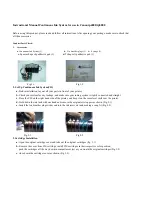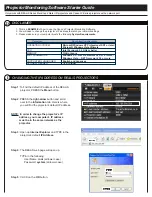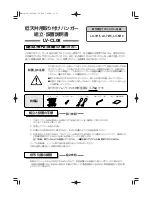
CChheecckkiinngg CCoonnttrroollss
Once the housing has been closed, make sure the housing
controls line up with the corresponding camera controls. If the
housing controls are misaligned slightly, make sure the camera
hold down bolt has been tightened down firmly so the camera
is flat against the tray.
TTuurrnn CCaam
meerraa O
Onn
Turn the camera on and operate each of the housing controls to
get a feel for using the camera in the housing. Take a few pictures
above water with the camera in the housing.
ZZoooom
m CCoonnttrrooll
(NOTE:) After you have used the
housing's zoom control, it must be
returned to the center position to
disengage. If the housing zoom
control is pushing the zoom lever
in either direction, you may not
be able to take a picture or access
any other function because the
camera is receiving a signal from
the engaged zoom control.
CClloossiinngg tthhee H
Hoouussiinngg
1. Place housing face down in your
lap or on flat surface.
2. Check to see that there is an
o-ring on the housing back and
that it is clean and in its proper
location.
3. Guide the back into the housing
front. The o-ring should touch the
housing all the way around. There
should be an even gap all the way
around between the housing and
the housing back.
4. Lift the lid snaps so they are
extended and place each lid
snap into the corresponding hook
on the housing back.
5. To close the housing, push
down on the lid snaps until
they snap into place . Lid
snaps on opposite sides of the
housing should be closed at the
same time. Be sure they are down
far enough to engage the lock.
D
Doouubbllee cchheecckk - Once the housing is closed, check the o-ring seal.
Check the gap between the housing back and the housing. It
should be even all the way around the housing.
Look through the clear plastic back at the o-ring. You should see
a darkened area where the o-ring is compressed against the
housing back. If you do not see an even black compression seal
all the way around the back, open the lid snaps, reseat the
housing back and close the lid snaps. Visually check the seal again.
o-ring
housing back
housing back
o-ring
even gap
all 4 sides
5
6
7
Engaged
Center Position
Disengaged
+
-
-
+
U
Ussiinngg FFllaasshh
U
Ussiinngg tthhee CCaam
meerraa’’ss BBuuiilltt--iinn FFllaasshh..
If you do not have an external flash, the camera’s built-in flash
can be used. See Diffuser instructions ((PPaaggee #
#88 &
& #
#99)).
NOTE: The camera’s built-in flash cannot be used with optional
Wide-Angle lenses.
IInnssttaalllliinngg tthhee CCaam
meerraa
1. Pull out on each housing control (except shutter release) until it
stops. This will get the controls out of the way for installing the
camera.
2. Remove the back from the housing. The mounting tray for the
camera is secured to the housing back. Position the camera on
the tray, and using a coin or screwdriver (preferred), secure it
with the mounting bolt which threads into the camera’s tripod
socket.
CCAAU
UTTIIO
ON
N::
Some camera tripod socket threads are plastic. The mounting
tray bolt is metal. Do not cross thread or over tighten as you
may damage the camera tripod socket threads.
CAMERA / MOUNT
Lid
Hook
O' Ring
Mounting Bolt
Mounting
Tray
8
D
Diiffffuusseerr aanndd D
Deefflleeccttoorr IInnssttaallllaattiioonn
Housing shown with Deflector installed.
Deflector
A diffuser and deflector are included
with the housing. The diffuser is
white transparent plastic. The
deflector is also white, but is not
transparent.
To install the diffuser or deflector,
spread the port clamp at the spring
end and slide over the lens port. The
white plastic should be placed in
front of the camera flash. The port
clamp should be pushed back against the front of the housing.
Diffuser/Deflector
material
Port Clamp
Spring
Spread to Install























